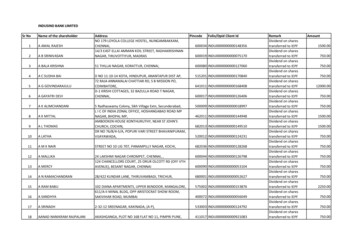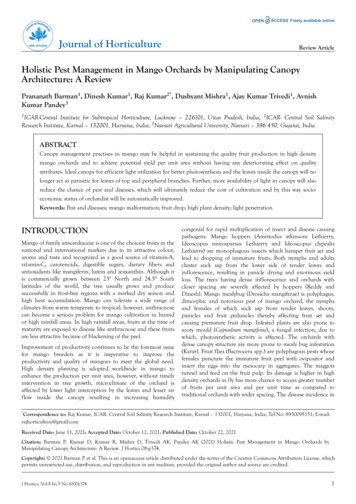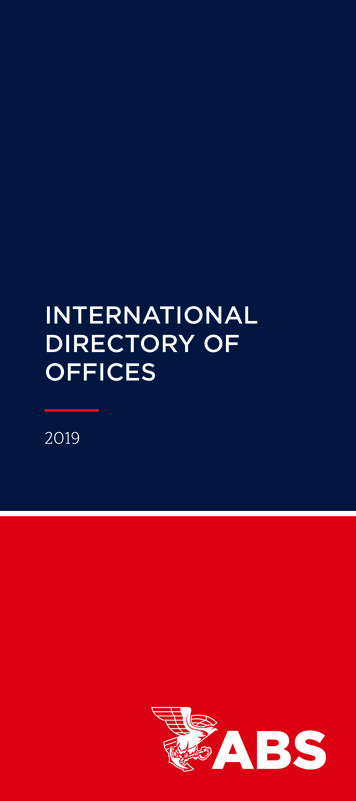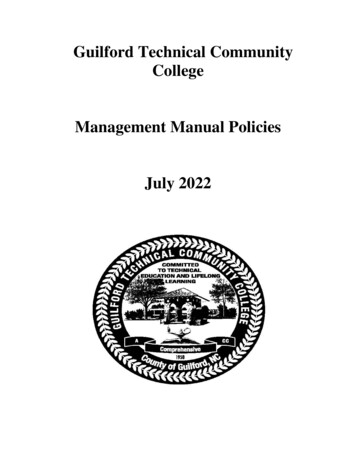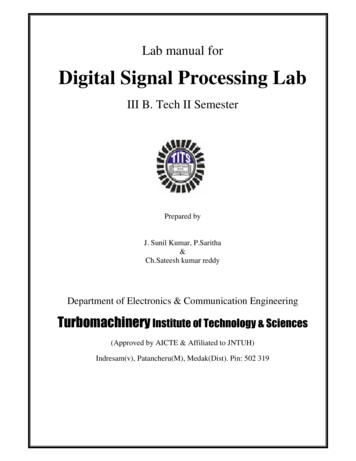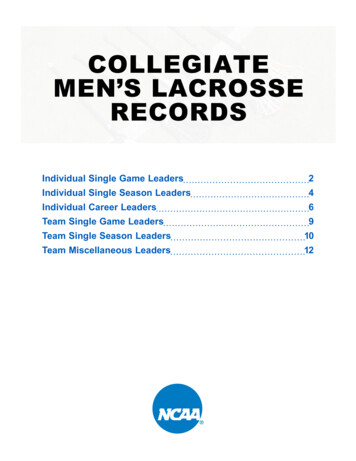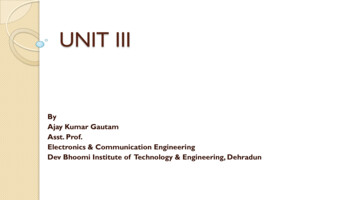
Transcription
UNIT IIIByAjay Kumar GautamAsst. Prof.Electronics & Communication EngineeringDev Bhoomi Institute of Technology & Engineering, Dehradun
SYLLABUS Optical Absorption in semiconductors,Types of Photo Diodes,Principle of photo detection,working and structures of p-i-n and APD photodetectors,noises in photo detectors,SNR,detector response time effects,comparison of various photo detectors.September 6, 2013By: Ajay Kumar Gautam, DBITW, Dehradun1
LECTURE PLANUNIT-III OPTICAL DETECTORSOptical Absorption in semiconductors2/329-332Types of Photo Diodes, Principle of photo detection2/328-329Working and structures of p-i-n and APD photo detectors1/223-230noises in photo detectors, SNR1/231-234detector response time effects1/235-239comparison of various photo detectors1/244September 6, 2013By: Ajay Kumar Gautam, DBITW, Dehradun2
Introduction In case of any communication, there must bea device which can receive the transmittedsignal.In case of OFC system, the first element ofthe receive is a photodetector.Photodetectors are semiconductor devicesthat can convert optical signals intoelectrical signals.September 6, 2013By: Ajay Kumar Gautam, DBITW, Dehradun3
Cond. The function of the photodector is to: sense the optical light convert it into electrical variations. Hence referred ‘O/E Converter.Since the optical signal is very weak anddistorted signal, so the photodetector mustbe able to sense the weak signals & it must behigh performance device.September 6, 2013By: Ajay Kumar Gautam, DBITW, Dehradun4
Basic Requirement for the Photodetectors1.Good Sensitivity: it must be able to produce maximum electrical signal for agiven amount of optical power, i.e., the quantum efficiency should be high.Fast Response Time: to obtain higher bandwidth3. Compatible Physical Dimensions: Small Size for efficient coupling to the fiber.4. Highly Stable: the performance characteristic of the detector must be2.independent of the ambient conditions.5.High Reliability: so that it can perform its function for a long timecontinuously.6.Low Biasing Voltages or Current: should not require excessive bias voltageor current.September 6, 2013By: Ajay Kumar Gautam, DBITW, Dehradun5
PHYSICAL PRINCIPLEOF PHOTODIODESeptember 6, 2013By: Ajay Kumar Gautam, DBITW, Dehradun6
PIN Photodector The pin refers to positive intrinsicnegative.September 6, 2013By: Ajay Kumar Gautam, DBITW, Dehradun7
Cond So, the device consists of 3 layers. P and N regions are separated by verylightly n-doped intrinsic (i) region. The reverse bias voltage is applied acrossthe device, so that the i region is fullydepleted of carriers. September 6, 2013By: Ajay Kumar Gautam, DBITW, Dehradun8
Cond. Now, the photon can give its energy andexcite an electron from the valance bandto the conduction band, only when theincident photon has an energy greater thanor equal to the band gap energy of thissemiconductor material.September 6, 2013By: Ajay Kumar Gautam, DBITW, Dehradun9
Cond.This process will generates mobileelectron-hole pairs as shown on nextslide. These electrons and holes are knownphotocarriers, since they are photogenerated charge carriers. September 6, 2013By: Ajay Kumar Gautam, DBITW, Dehradun10
September 6, 2013By: Ajay Kumar Gautam, DBITW, Dehradun11
Cond.These charge carriers are available toproduce a current flow, when a biasvoltage is applied across the device. The most of the incident light is absorbedin the depletion region, so thephotocarriers are generated in thisdepletion region. September 6, 2013By: Ajay Kumar Gautam, DBITW, Dehradun12
Cond. A high electric field is available in the depletionregion, so it will cause the carriers to separate.These carriers are collected across the reversebias junction.The current will flow because of these carriers.The one electron will flow for every carrier pairgenerated.This current is known as photocurrent.September 6, 2013By: Ajay Kumar Gautam, DBITW, Dehradun13
Cond.Since the charge carriers flow through thematerial, the electron-hole pair willrecombine and hence disappear. On average, the charge carriers move adistance Ln or Lp for electrons and holesrespectively. September 6, 2013By: Ajay Kumar Gautam, DBITW, Dehradun14
Cond.This distance is known as the diffusionlength. The time for recombination or electronor hole is known as carrier lifetime. The lifetime and the diffusion lengths arerelated by: L D & L D nn nSeptember 6, 2013pp pBy: Ajay Kumar Gautam, DBITW, Dehradun15
Cond.Ln & Lp Diffusionlength for elctrons & holes respectively n & p Carrier Lifetime for elctrons & holes respectivelyDn & Dp Diffusion coeffient for elctrons & holes respectively As a photon flux Φ penetrates into asemiconductor, it will be absorbed as itprogresses through the material.September 6, 2013By: Ajay Kumar Gautam, DBITW, Dehradun16
Cond.Let, Pin is the optical power level, that fallson the photodector at x 0 and P(x) isthe power level at distance x into thematerial. The incremental distance dx in thesemiconductor is given by: dP( x) s ( ) P( x)dxSeptember 6, 2013By: Ajay Kumar Gautam, DBITW, Dehradun17
Cond. Integrating this relation gives,P( x) Pin e s ( ) x s is photon absorption coefficient The upper wavelength cutoff isdetermined by band-gap energy Eg of thematerial.September 6, 2013By: Ajay Kumar Gautam, DBITW, Dehradun18
Cond. c ( m) hc1.24 Eg (eV ) Eg (eV )The photocurrent IP produced by incidentlight of optical power Po is given by:qIp Pin (1 s w)(1 R f )h September 6, 2013By: Ajay Kumar Gautam, DBITW, Dehradun19
Cond. Where, Rf is reflectivity at the entrance of thephotodiode Pin is the optical incident power q is the electron charge hv is the photon energySeptember 6, 2013By: Ajay Kumar Gautam, DBITW, Dehradun20
Cond.Photodector have two quantum efficiencyand its response speed. These parameters depend on the materialband gap, the operating wavelength, andthe doping and thickness of the, p, i, and nregions of the device. September 6, 2013By: Ajay Kumar Gautam, DBITW, Dehradun21
Cond. The quantum efficiency is the no ofelectron-hole carrier pair generated perincident is given by:Ip / qno of electron hole pair generated no of incident photonsPin / h R IpPin qh September 6, 2013By: Ajay Kumar Gautam, DBITW, Dehradun22
Cond.R is the responsivity of the photodiode. The photocurrent (Ip) is directlyproportional to the incident opticalpower (Pin). Quantum efficiency varies according tothe photon energy. September 6, 2013By: Ajay Kumar Gautam, DBITW, Dehradun23
Avalanche PhotodiodesSeptember 6, 2013By: Ajay Kumar Gautam, DBITW, Dehradun24
Problems: Example 6.1, 2, 3 4, 6 & 7 from Keiser.September 6, 2013By: Ajay Kumar Gautam, DBITW, Dehradun25
Review Problems How is silicon RAPD operated? How does it differ from p-i-nphotodiode? What are the advantages and disadvantages?[UPTU2009-10]Define quantum efficiency and responsivity of a photo-detector.Calculate the transit time for silicon photodiode which has asaturation of 105 ms-1. The depletion layer thickness is 7 µm.[UPTU 2009-10]Explain the requirements of optical detector to be used for thepurpose of optical communication.What are the parameters bywhich performance of optical detector can be judged?[UPTU2010-11]September 6, 2013By: Ajay Kumar Gautam, DBITW, Dehradun26
Review Problems Describe the working and principle of pin photodiode. How itsefficiency can be increased. [UPTU 2010-11]Write short notes [UPTU 2010-11] RAPD photo-detector Noise sources in optical fiber communication. What is the significance of intrinsic layer in PIN diode? What is theprinciple of working of PIN diode [UPTU 2011-12]Define quantum efficiency and responsivity of a photodiode.Determine the wavelength at which quantum efficiency andresponsivity are equal [UTU 2011-12]September 6, 2013By: Ajay Kumar Gautam, DBITW, Dehradun27
Review Problems Discuss the working principle of avalanche photodiode, how itdiffers from p-i-n photodiode? State the advantages and drawbackswith the use of the RAPD as a detector for optical fibercommunications. [UTU 2011-12]Explain the physical principle of APD. What is the temperatureeffect on Avalanche Gain? Describe Automatic Gain Control usingOp-amp. [UPTU 2011-12]Explain the working of a P-I-N photodiode. Also explain the factorsthat limit the speed of response of photodiode [UTU 2012-13]Explain the impact ionization in avalanche photodiodes. Definephoto multiplication factor and cutoff over length of photodiode.[UTU 2012-13]September 6, 2013By: Ajay Kumar Gautam, DBITW, Dehradun28
Review Problems Discuss the expression for the SNR in an APD receiver. How thesignal to noise ratio may be modified to give the optimumavalanche multiplication factor [UTU 2012-13]Describe surface LED and PIN photodiode always operative inreverse bias region. [UTU 2012-13]September 6, 2013By: Ajay Kumar Gautam, DBITW, Dehradun29
REFRENCES1.Optical Fiber Communications – Gerd Keiser, Mc Graw-Hill International edition,4TH Edition, 2008.2.Optical Fiber Communications – John M. Senior, PHI, 2nd Edition, 2002.3.Optical Fiber Communications – Gerd Keiser, Mc Graw-Hill International edition,2ND Edition, 2000.4.Fiber Optic Communication Systems – Govind P. Agarwal , John Wiley, 3rd Edition,20045.Text Book on Optical Fibre Communication and its Applications – S. C. Gupta, PHI,2005.6.Fiber Optic Communications – D.K. Mynbaev , S.C. Gupta and Lowell L. Scheiner,Pearson Education, 20057.Optical Communication System- R. K. Singh, Wiley India, DelhiSeptember 6, 2013By: Ajay Kumar Gautam, DBITW, Dehradun30
Noise sources in optical fiber communication. . Optical Fiber Communications -Gerd Keiser, Mc Graw-Hill International edition, 2ND Edition, 2000. 4. Fiber Optic Communication Systems -Govind P. Agarwal , John Wiley, 3rd Edition, 2004 5.

